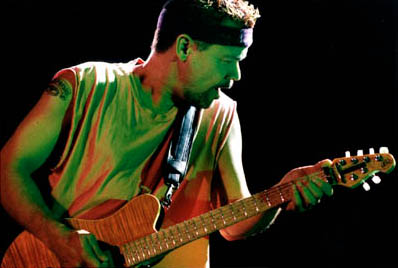


 |
 |
 |
 |
 |
 |
 |
 |
 |
|---|
|
Edward Van Halen's guitars ERNIE BALL MUSIC MAN
In the late eighties, Edward became deeply insatisfied with Kramer, because they couldn't keep up with production and had started to manufacture guitars in Asia, without Ed's consent.
 After that, he felt it was time to move on and so he started looking for a new partnership.
After that, he felt it was time to move on and so he started looking for a new partnership.He said that there were too many people sending him striped prototypes of guitars and, just like so many times before, he had different thoughts. He settled with Sterling Ball's company because they could maintain a high quality standard while delivering him a guitar "designed by EVH" himself. The guitar was much sought after when Edward left. The fact that production was limited to 1800 units a year and that the neck had no wax finish (once the neck gets dirty, it's practically impossibe to reverse the aged/used look on the neck) which made these guitars really collectable items, specially the rare finishes, like natural, green, pink or gloss black. This had been the first time that EVH was designing a guitar rather than endorsing one. In one of the magazine ads, Ed was quoted: "...I used to endorse the guitar I played. I designed this one... big difference."
There were produced approximately 6000 of these guitars from approximately January of 1990 to September of 1995 when the last one rolled out the door. The estimate was about 1200 per year although that would put the total number closer to 7000. This is a recently provided number. They don't give out an exact number. I personally believe it is a little higher than this when you look at the serial number run but that is nothing more than my guess. How Rare is the color?... The most common colors are red, gold (amber), blue and purple with about 1400 of each. This includes the stop tails as approximately 200 of the red, purple and amber were stop tails (about 600 total of these). There are about 600 trans black and 600 sunburst. I am not sure on the Natural but I would say 400 is a good guess. They only made about 200 pink. Green is said to be the third rarest color with 96 total pieces produced.  The rarest color is solid black at 16 pieces, followed by solid gold at 26 pieces. These figures come from a very knowledgeable collector who got them from Music Man years ago and from another collector who for the most part had the same figures. I can't say for sure that they are correct but I think they are at least close.
The rarest color is solid black at 16 pieces, followed by solid gold at 26 pieces. These figures come from a very knowledgeable collector who got them from Music Man years ago and from another collector who for the most part had the same figures. I can't say for sure that they are correct but I think they are at least close.The serial number surprise... the serial numbers on these guitars are not consecutive. You can't tell the day, month and year the guitar was produced by looking at the serial number. The reason is that EB/MM had the serial number plates produced all at once and they came back from the supplier out of order and EB/MM didn't think it was worthwhile to put them in order. So they just used them somewhat randomly. Also, some serial number plates that had quality problems or got scratched were never used. The only way to positively identify the production date is to ask EB/MM. They can type the serial number into their computer and get the date of production. Considering color issues... ever wondered why you will see the same color guitar but the colors look very different? According to a tech who worked on these guitars, they used a dye for a long time that was subject to extreme fading and it could happen very quickly. In as little as 6 to 12 months an amber (gold) guitar could completely loose its pigment and look like a Natural. He said he has seen cases where it is impossible to tell the original color was gold. He also sayd the resulting natural look is very cool and really shows off the wood but it is very different. The only way to know the guitar was originally gold is to look it up in the computer and see what it was built as. The "aqua" color is a result of ageing on a trans-blue. Ever seen a red one advertised as a unique color such as "dusky rose"? This the same effect. Even after they switched to a different dye he said the guitars will still fade based on their exposure to UV although not as badly as the earlier ones. Another colour issue: is a guitar it really green, solid gold or solid black? Before paying a lot of money for a "rare" color Ernie Ball Music Man, one should check with the manufacturer to see what the serial number shows it was originally built as. They have been approached by people looking to re-paint their guitars green, solid gold or solid black. They will refuse to do it but that doesn't mean it can't be done someplace else! One more piece of advice: don't take those strings all the way off! When changing the strings always leave one string with tension. Ernie Ball says you can very easily ruin the neck and your guitar by releasing the string tension without loosening the truss rod. It is a very bad idea to ship the guitar with loose strings or without strings unless you had adjusted the truss rod. Here's Edward with one of the early prototypes:  |